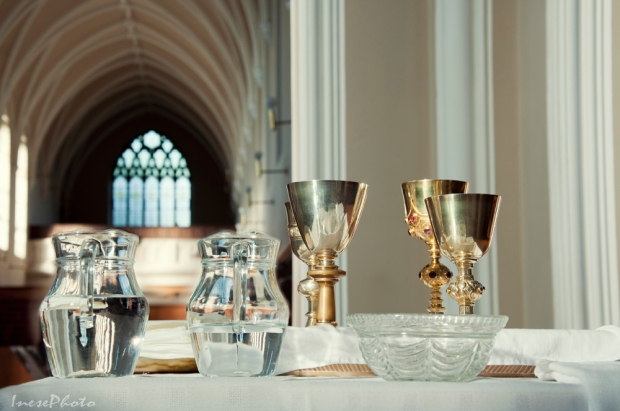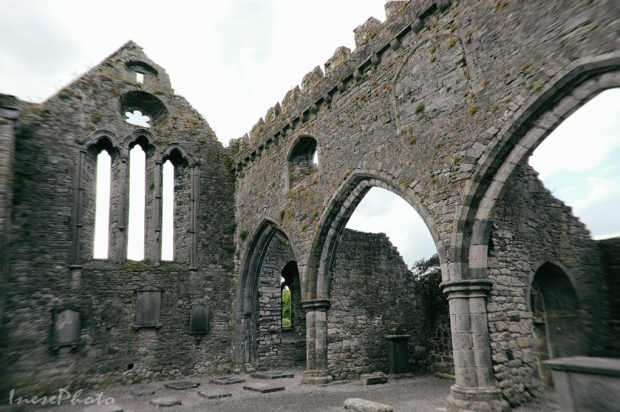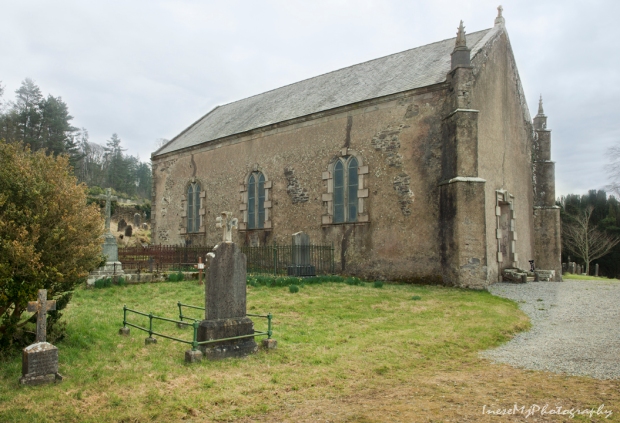Pat The Fox Man and I set off on our historical tour. Pat has never been in Jerpoint Abbey before, and it was fantastic that he had got a tour guide to himself. I and my camera were trailing behind them.
In the pictures: Pat Gibbons and his tour guide Margaret Brophy. I was delighted that Pat had such a knowledgeable guide. Their conversation went beyond the history of the abbey to the history of the whole parish.
Originally a Benedictine monastery built in 1160, Jerpoint Abbey was affiliated to the Cistercian Order in 1180. Scholars believe that Domnall I, the king of Ossory who died in 1176, was possibly the founder of the monastery. This is supported by a charter of King John to Jerpoint Abbey confirming the lands granted by Domnall. The grant happened before Strongbow arrived in Leinster in 1170.
The restoration works are on in the abbey. Some areas are fenced and the north aisle is closed.
You can see the scaffolding in the north isle, behind the arcade of pointed arches supported by large piers. There are six arches, with different design on each pier. Margaret and Pat are walking to the Romanesque west nave – the lay brothers’ choir. It is the place where the lay brothers gathered to attend Mass. The nave originally had an arcaded aisle on both sides. There is a special room in the museum where all the broken pieces of masonry – particularly the parts of arches and piers – are stored and can be viewed by the visitors.
The west nave window comprises of three round-headed lights.
The Monk’s choir is the east part of the nave.
This is what the windows look like in the morning light from the main road.
The crossing tower above the intersection of the chancel, nave and transept was added in the 15th century. Towers were not allowed by the Order’s authority at the time the monastery was built. The rib vaulting of the tower’s ceiling is well preserved. The pointed arches open to the nave, chancel and both transepts. Each transept has two chapels on the east side.
There are a tomb and funeral slabs in the crossing.
I went to the north transept to check out the chapels. And this is what I found.
Of course I stuck there for a long time watching the mama swallow and her “yellow-lipped” babies.
There is something else quite amazing in the chapels – beautifully carved tomb weepers decorating the mensa-tomb chests. In the picture below you see six weepers – the apostles who can be recognized by the attributes related to the manner of their martyrdom. From the left: St John with a chalice; St Thomas with a lance; St Simon with a saw; St Bartholomew with skin – it is believed he was flayed alive; St Paul holding a sword, and St Matthew an axe. The carvings were made by the sculptor Rory O’Tunney of Callan.
These weepers are St Catherine of Alexandria with a wheel, St Michael the Archangel in the centre, and St Margaret of Antioch wearing a ring broach and stomping on a dragon’s head.
I left the chapels and went to the presbytery to admire the ancient wall paintings.
In the image below, you see three tomb niches in the wall under the painted fragment. It is where two tomb effigies from the next picture were originally placed.
The tomb effigy in background represents Felix O’Dulany, the first Abbot of Jerpoint praised for his ‘zeal, charity and prudence’. The other effigy (foreground) possibly represents Donal O’Fogarty, another bishop of the Diocese of Ossory.
Bishop O’Dulany died in 1202. They say ‘many miracles were wrought by him’. The face of the effigy is badly worn: it was believed that pilgrims touching the face would be cured of their illnesses.
This is a 15-16th century wall painting after the restoration works. You can see the fragments of two shields with the scallop shells and wild boars – four shells and possibly four boars. Scallop shells represent St James and are the symbol of pilgrimage. I am not sure about the boars. Usually they represent ferocity and power. I should have listened to Margaret’s explanation instead of looking for birds 🙂
The abbey is famous for its large number of stone carvings untypical for a Cistercian monastery. You will find amusing figures of animals and fantastic creatures, knights, damsels, monks and smiling bishops carved on the piers. There are so many carvings that when you come again you will find something new you haven’t seen before.
The west part of the cloister arcade is reconstructed. You will find many lay and religious carvings there, and learn about the armor and clothing worn at the times.
The famous ‘man with the stomach ache’.
View of the tower from the west side of the cloister arcade.
The south part of the cloister arcade also survive.
This part of the arcade would support the roof over the buildings like refectory (dining room) and calefactory (warming house) which are long gone.
As you see in the picture, there is an upper floor that can be reached from the south transept. It is where the monks’ dormitory was located. I want to return to the abbey next year, so I leave the upper floor for my future blog post.
Beautiful Gothic east window dates from the 14 century. You can see the outer halves of two old Romanesque windows – originally a triple window.
Clicking on this link you will find a detailed map of the abbey.
The graves around the abbey date from centuries ago to the present time.
We visited Jerpoint Abbey on a fine sunny day. I want to share a different mood – a poem written by Waterford-born journalist Samuel Carter Hall in 1823, and a series of photographs taken on a gray and foggy morning – all of this in the article written by an author and lecturer Robert O’Byrne.
You have visited one of the finest historical places in Co Kilkenny. Our day out isn’t over yet. It continues to the next blog post 🙂
 Have a wonderful weekend!
Have a wonderful weekend!









































 Have a wonderful weekend!
Have a wonderful weekend!



















 Have a wonderful weekend!
Have a wonderful weekend!